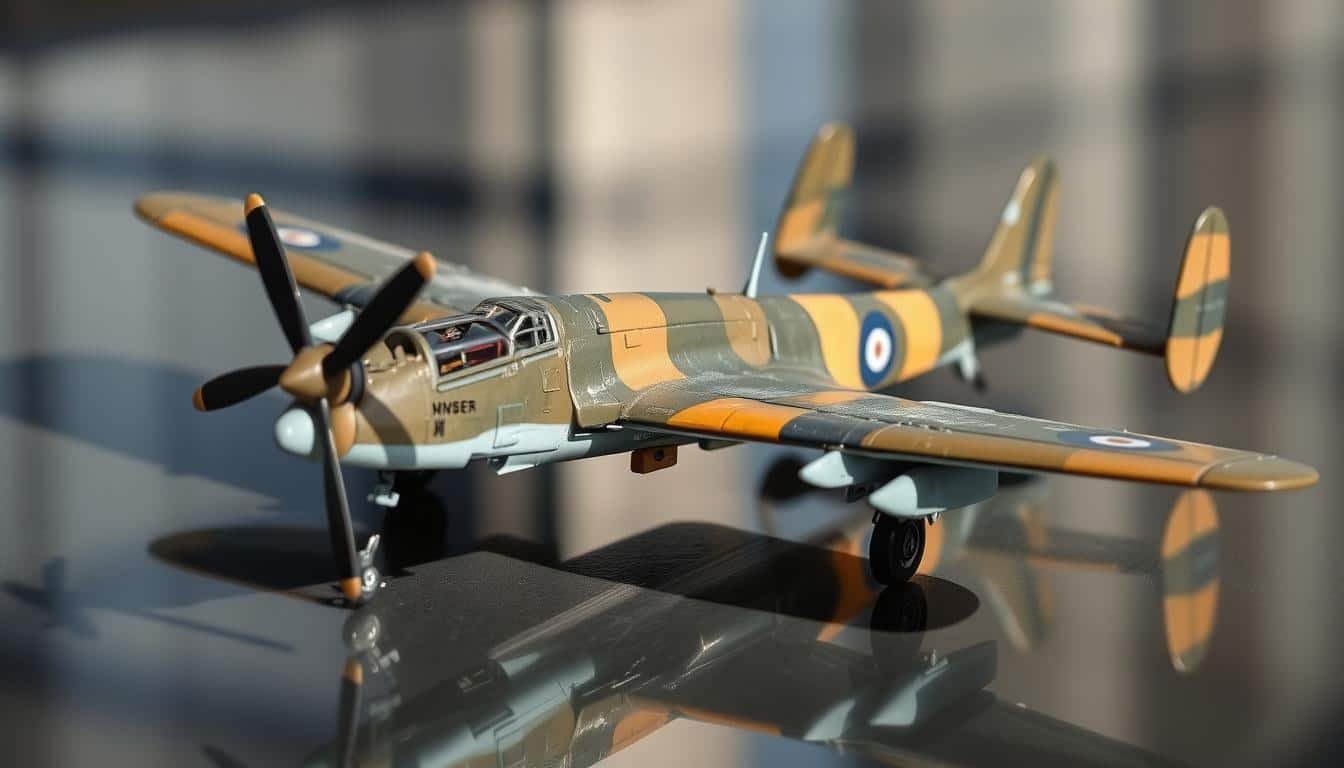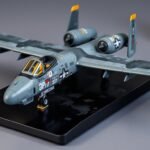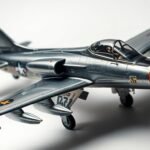Ever thought about how a legendary World War II plane like the De Havilland Mosquito fits into a 1:72 scale model? This detailed diecast replica is just 6.75 inches long and 9 inches wide. It shows the amazing engineering of the “Wooden Wonder” that flew during a key time in history.
This De Havilland Mosquito model is made from diecast metal and ABS plastic. It captures the aircraft’s unique features and is built to last. With its matt black body and dark red markings, it looks just like the real thing. Every detail, from the RAF roundels to the squadron code, is spot on.
Key Takeaways
- 1:72 scale De Havilland Mosquito diecast model
- Impressive 6.75-inch length and 9-inch wingspan
- Constructed with diecast metal and ABS plastic for durability
- Precise details including color scheme, markings, and squadron codes
- Includes a free display stand for in-flight presentation
The Legacy of the Wooden Wonder: Historical Overview
The De Havilland Mosquito started its journey in World War II’s chaotic times. It was designed as an unarmed fast bomber. It first flew in November 1940, quickly becoming a marvel of British engineering and military aviation history.
Birth of a Legend: Development and Innovation
The Mosquito’s wooden construction was a game-changer. It used mahogany wood instead of metal, saving weight and boosting speed. At its peak, four production lines made one Mosquito every day, showing the war effort’s scale and the dedication of those involved.
Combat Versatility and Roles
The Mosquito shone in many military roles, like night fighter, bomber, and reconnaissance. Its design made it easy to modify for different tasks. It had the lowest loss rate in Bomber Command, thanks to its speed and agility, even without guns.
Speed and Performance Achievements
With two Rolls-Royce Merlin engines, the Mosquito could hit over 400 mph. It had 3,000 horsepower and could carry heavy bombs, like the B-17 Flying Fortress. This made it a true “Wooden Wonder” of the Royal Air Force.
The Mosquito’s impact went beyond World War II. It served in many roles across different theaters, earning a special place in military aviation history.
| Key Achievements | Details |
|---|---|
| Speed | Capable of reaching speeds over 400 mph, making it one of the fastest operational aircraft during World War II. |
| Bomb Load | Able to carry a bomb load comparable to the B-17 Flying Fortress, despite being a significantly smaller aircraft. |
| Production Rate | At the peak of production, one Mosquito emerged from each of the four production lines every day. |
| Loss Rate | Initially had the lowest loss rate of any aircraft in Bomber Command due to its exceptional speed and maneuverability. |
De Havilland Mosquito Diecast Model Specifications

For those who love aviation and collecting, the De Havilland Mosquito diecast model is a gem. It’s a detailed replica of the “Wooden Wonder” from World War II. This model is made with great care and shows the iconic British fighter-bomber in a 1:72 scale.
The model is big, measuring 6.75 inches long and 9 inches wide. It looks just like the real thing, with all the right details. From the panel lines to the surface textures, it’s a joy for warbird fans.
| Specification | Detail |
|---|---|
| Price | $26.95 |
| Scale | 1:72 |
| Length | 6.75 inches |
| Width | 9 inches |
| First Flight | November 1940 |
| Fastest Operational Aircraft | 1941 |
| Unit Equipped | 23 Squadron RAF |
| Basing | Luqa, Malta (1943) |
| Variant | NF.Mk II |
| Engines | Rolls-Royce Merlin |
The model has a cool matt black body with dark red markings. It looks just like the 23 Squadron RAF’s plane. The RAF roundels on the wings and fuselage make it even more authentic.
The cockpit canopy is detailed, with a “No Step” notice. This adds to the model’s realism and makes it a hit with collectors and enthusiasts.
This De Havilland Mosquito diecast model is a must-have for anyone interested in aviation history. It’s perfect for displaying alone or as part of a larger collection.
Technical Details and Combat Capabilities
The de Havilland Mosquito was a top-notch World War II aircraft. It was known for its speed and versatility. Powered by two Rolls-Royce Merlin 21 or 23 engines, it could hit speeds over 380 mph.
Its armament included four 20mm cannons and four .303 inch machine guns. This made it a powerful fighter. It could also carry bombs, rockets, or torpedoes for different missions.
Notable Combat Operations
The Mosquito showed its strength in several key missions. One famous raid was on Amiens prison in France in 1944. Mosquitoes carried out a low-level strike to free French Resistance fighters.
Another notable mission was against the Gestapo headquarters in Oslo, Norway. This showed the Mosquito’s skill in precise strikes.
Variant Configurations
The Mosquito had many variants for different missions. There was the PR MkI for reconnaissance and the B MkIV bomber. The NF MkII was a night-fighter, and the FB MkVI was a fighter-bomber.
The FB MkXVIII was designed for anti-shipping missions, with a 57mm Molins gun. Each variant was made for specific tasks, showing the Mosquito’s flexibility. This made it a valuable asset for the Royal Air Force.
FAQ
What is the scale of the De Havilland Mosquito diecast model?
What are the dimensions of the De Havilland Mosquito diecast model?
What materials are used in the construction of the De Havilland Mosquito diecast model?
Does the De Havilland Mosquito diecast model require any assembly or painting?
What are the key features that capture the essence of the De Havilland Mosquito?
What are the performance characteristics of the De Havilland Mosquito?
What were some of the notable combat operations of the De Havilland Mosquito?
What were the main variants of the De Havilland Mosquito?
Source Links
- RAF De Havilland Mosquito FB MkVI Diecast Model Aircraft – https://airmodels.net/de-havilland/376-de-havilland-mosquito-fb-mkvi.html
- Mosquito NF.Mk II 1:72 Diecast Model – Oxford Diecast OD-AC102 – https://www.flyingmule.com/products/OD-AC102?srsltid=AfmBOoqAt3ZkadFJKsaq4VFhKaByLLWikYp_yLsSs2eVU0oTZ8oKJubJ
- De Havilland Mosquito: The wooden fighter-bomber – https://www.iwm.org.uk/de-havilland-mosquito-wooden-wonder
- De Havilland Mosquito D-Day Markings – https://planearts.com/product/de-havilland-mosquito-d-day-markings-wood-replica-scale-custom-model-aircraft/
- Mosquito NF.Mk II 1:72 Diecast Model – Oxford Diecast OD-AC102 – https://www.flyingmule.com/products/OD-AC102?srsltid=AfmBOornN5tW72BX6bZEnv-8bOfwVvpsJpTWqDIjnt9qK8Z1fWLl3S3d
- Mosquito Models – http://www.mossie.org/models/Mosquito_models.htm
- Mosquito NF.Mk II 1:72 Diecast Model – Oxford Diecast OD-AC102 – https://www.flyingmule.com/products/OD-AC102?srsltid=AfmBOooSCO4BKR2n3-oG8FTjs05c8g4aNkT4boElOtLQbzRJCfN7FP6j
- 1/32 SCALE DE HAVILLAND MOSQUITO FB MK.VI – https://www.tamiya.com/english/products/60326/index.html
- Revell 1/32 de Havilland DH98 Mosquito Mk IV, Built as a PR IV – https://www.largescaleplanes.com/articles/article.php?aid=3569








Anyone else think the De Havilland Mosquito is overrated? Sounds controversial, but I reckon there were more innovative aircraft of that era! Lets debate! 🛩️
Interesting article, but isnt it odd to romanticize war machines? Shouldnt we focus more on the human element, not the weapons?